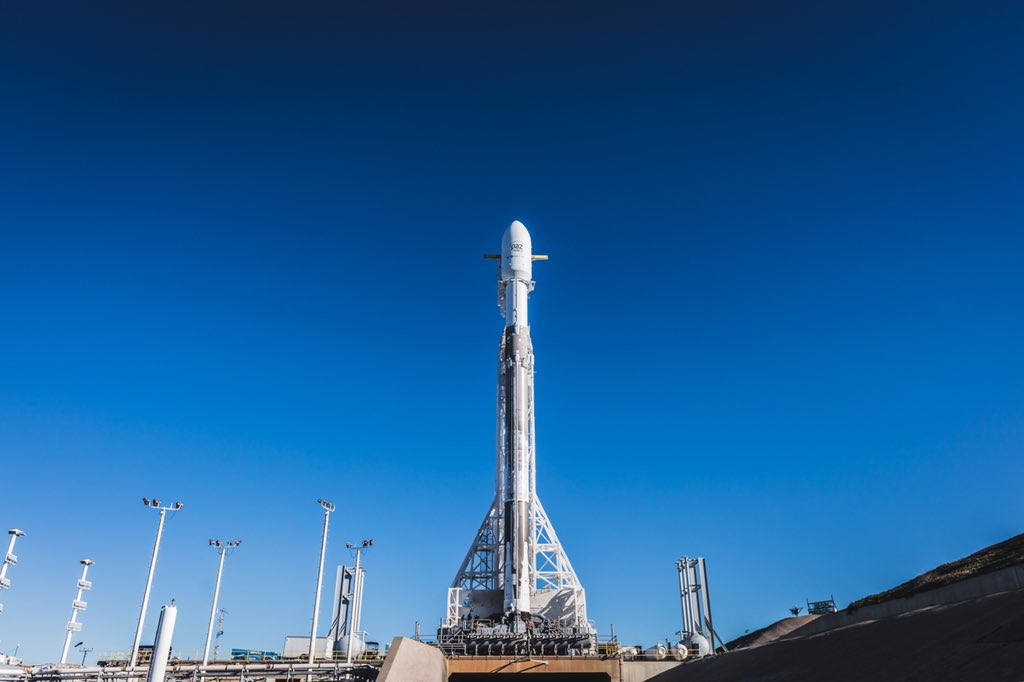SpaceX Delays Falcon 9 Rocket Launch Due to High-Altitude Winds

Update for Feb. 22: SpaceX's Falcon 9 mission to launch the Paz satellite has successfully lifted off. See our full story here: SpaceX Launches 1st Test Satellites for Starlink Internet Constellation Along with Spain's Paz
SpaceX called off an attempted launch of its Falcon 9 rocket in California today (Feb. 21) due to strong high-altitude winds, according to the company's CEO, Elon Musk.
The Falcon 9 rocket was scheduled to lift off at 9:17 a.m. EST (1417 GMT) from Space Launch Complex 4E at California's Vandenberg Air Force Base. But about 10 minutes before liftoff, SpaceX announced it was standing down from the launch try.
"High altitude wind shear data shows a probable 2% load exceedance. Small, but better to be paranoid," Musk wrote on Twitter. "Postponing launch to tomorrow, assuming winds are better then."
The next opportunity to launch the Falcon 9 will be Thursday (Feb. 22) at 9:17 a.m. EST. The mission has been delayed three times since its initial launch target of Feb. 17, twice due to the need for additional checks of the launch vehicle.
SpaceX's primary mission for this launch is to deliver the Paz radar-imaging satellite into orbit for the Spain-based company Hisdesat. It will provide imagery for both commercial and government uses, according to a mission description.
The Falcon 9 is also carrying two small prototypes for SpaceX's planned Starlink broadband internet satellites on this mission. The two satellites, called Microsat-2a and Microsat-2b, are the vanguard of a massive constellation of 4,000 satellites that SpaceX is developing to provide low-cost internet service to people around the world.
Get the Space.com Newsletter
Breaking space news, the latest updates on rocket launches, skywatching events and more!
"Today’s Falcon launch carries 2 SpaceX test satellites for global broadband," Musk wrote on Twitter. "If successful, Starlink constellation will serve least served."
SpaceX representatives have said they hope to have the Starlink constellation running in at least a limited capacity by 2020.
The Falcon 9 launching Paz and the Starlink prototypes has flown in space before. The rocket's first-stage booster launched the Taiwanese Earth-observing satellite Formosat-5 into orbit in August 2017 and returned to Earth, landing on one of SpaceX's drone-ship platforms. SpaceX will not attempt to recover this Falcon 9 first stage after the Paz satellite launch, according to a mission description.
The Falcon 9 launch from Vandenberg is not the only flight SpaceX is preparing for this week. The company is also scheduled to launch the Hispasat 30W-6 communications satellite into orbit from one of its Florida pads on Sunday (Feb. 25).
Earlier today, SpaceX announced that it had successfully completed a static fire engine test of the Falcon 9 rocket that will launch Hispasat 30W-6. The mission is scheduled to lift off from Space Launch Complex 40 at Cape Canaveral Air Force Station in Florida at 12:35 a.m. EST (0535 GMT), according to Spaceflight Now.
If SpaceX proceeds with a Paz satellite launch on Thursday, you can watch the Falcon 9 liftoff here or directly via SpaceX's website. The webcast will begin about 15 minutes before the scheduled launch.
Email Tariq Malik at tmalik@space.com or follow him @tariqjmalik and Google+. Follow us @Spacedotcom, Facebook and Google+. Original article on Space.com.
Join our Space Forums to keep talking space on the latest missions, night sky and more! And if you have a news tip, correction or comment, let us know at: community@space.com.

Tariq is the Editor-in-Chief of Space.com and joined the team in 2001, first as an intern and staff writer, and later as an editor. He covers human spaceflight, exploration and space science, as well as skywatching and entertainment. He became Space.com's Managing Editor in 2009 and Editor-in-Chief in 2019. Before joining Space.com, Tariq was a staff reporter for The Los Angeles Times covering education and city beats in La Habra, Fullerton and Huntington Beach. In October 2022, Tariq received the Harry Kolcum Award for excellence in space reporting from the National Space Club Florida Committee. He is also an Eagle Scout (yes, he has the Space Exploration merit badge) and went to Space Camp four times as a kid and a fifth time as an adult. He has journalism degrees from the University of Southern California and New York University. You can find Tariq at Space.com and as the co-host to the This Week In Space podcast with space historian Rod Pyle on the TWiT network. To see his latest project, you can follow Tariq on Twitter @tariqjmalik.










